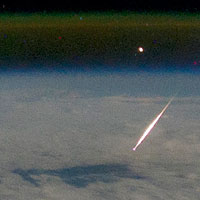Caught on video: the moment meteor explodes over Russian city
posted Sunday, February 17, 2013 at 2:19 PM EST

Early on Friday morning local time, the industrial city of Chelyabinsk in southwestern Russia made headlines around the world. As commuters traveled to work and children started school, a massive meteor disintegrated in the skies overhead, in what's known as an airburst.
Such events are, it has to be said, relatively commonplace -- but this one is decidedly different, for several reasons. Not least of these is that numerous cameras were recording at the crucial moment, and videos of the event and its immediate aftermath quickly found their way online and to global news networks. It's the first time that a meteor event of this magnitude has been so thoroughly documented on camera, and the results make for some incredible viewing.
Meteors enter earth's atmosphere fairly frequently, but the vast majority are small and go little-noticed over the sea or unpopulated areas. Airbursts on the scale seen at Chelyabinsk are much less common. Early reports from NASA suggest that this was a once-in-a-century event. Even more rare is that it happened over a large city, where people (and their cameras) saw every detail.
With over a million inhabitants, Chelyabinsk is the ninth-largest city in Russia, with a population similar to Dallas, Texas or the Belgian capital in Brussels. The meteor exploded above the city's residents at around 9:20am local time, not long after dawn and while many were still in the midst of their morning commute. In Russia, where dashboard-mounted cameras are commonplace as a tool to document incidents on the roads, more than a few cameras were aimed in the right direction and recording at the crucial moment. Closed-circuit TV cameras, too, caught early morning turned bright as a midday sun by the fiery meteor overhead.
Other citizens of Chelyabinsk -- whether on foot, or perhaps already settling in for their day at work or school -- stood ready to record the event as well, with camera phones close to hand just as in any modern city. While most weren't quick enough to catch the meteor itself, their videos documented hundreds of miles of smoke trail left behind, as its outer layers were seared off by ram pressure heating. They also captured the effects of the shockwave, which took another minute or two to span the many miles to ground level.
The response from those seen in the videos, set to a surreal backdrop of thunderous sonic booms and shattering glass, is surprisingly calm and measured. Several of the more interesting videos accompany this article. If you're a Russian speaker, please do note that these videos may -- perhaps understandably -- contain some adult language. We don't speak Russian ourselves, and so can't confirm what's being said in any of the clips.
According to NASA's latest estimates, the meteor is believed to have had a diameter of around 55 feet, about ten feet longer than a typical US schoolbus. Estimated mass was in the region of 10,000 tons, suggesting a fairly dense rocky makeup. Within just 32.5 seconds of entering earth's atmosphere somewhere over Alaska at a shallow 20-degree angle and with a staggering speed of 40,000 miles per hour, the meteor broke up some 12-15 miles above the city. Although NASA scientists believe some large debris will have made it to the ground, it won't have been the cause of the damage. The altitude and speed at which the meteor shattered will have allowed the debris to continue on for many miles past the city, and into the snowy countryside beyond.
Instead, it was the shockwaves created by the meteor's explosion that shattered windows across Chelyabinsk, and in at least one case caused the partial collapse of a building. That explosion, NASA says, released around 500 kilotons of energy. By way of comparison, the two atomic bombs dropped over Hiroshima and Nagasaki towards the end of World War II released 16 and 21 kilotons respectively. In fact, the meteor's energy release was equal to that of Ivy King, the largest pure fission bomb ever tested by the United States.
Thankfully, given the event's proximity to such a large urban area, there haven't yet been any reports of fatalities. Over a thousand people are said to have sought medical assistance, however, making this the most significant meteor event on record in terms of the number injured. Most of these injuries are reportedly due to broken glass, and only around fifty individuals required hospitalization. Reporting from the New York Times gives some insight on these, including a teacher who saved many of her students with an order to hide under their desks after the initial flash of light, but reportedly sustained a serious injury from broken glass herself. Early estimates are that damage is in the region of a billion rubles (US$33 million).
As for the meteor itself, although a search is underway, no signs have yet been found of where it landed. Early reports were that a large piece of the meteor had splashed down in nearby Lake Chebarkul, but more recent articles suggest that divers have completed a search of the lake without finding any evidence to back this up. It's likely that some traces will eventually be found, but with the debris spread over a large and mostly uninhabited area, it's certain to take some time. Whatever can be found will likely have significant value for research, and may have a lot to tell us about the meteor itself. Even if no trace is found, though, the event has already been documented more richly than any other we can recall, thanks to the pervasive nature of digital imaging.
(Image of Perseid meteor from International Space Station courtesy of NASA.)